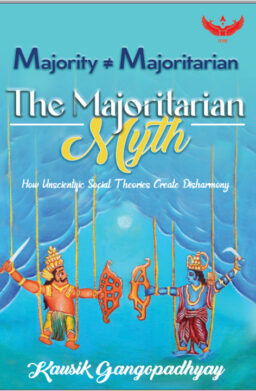A New Window to Understanding Social Dynamics of Indian Unrest
India is home to exquisite stone temples carved delicately. The artisans, however were unaware of the geology of those rocks and their chemical composition that lent them perfect texture and proportions for such intricate carving until the arrival of modern methods of geological enquiry and the geochemistry lab. These methods merely provided a scientific explanation to technical knowhow mastered by the great artisans through generations.
In the context of Sociology in India, that Hindu Majoritarian and its actual role in inter-communal tension as a proverbial red herring is accepted wisdom. This yeomen service of providing a technical framework and understanding is the major giveaway of Kausik Gangopadhyay’s book “The Majoritarian Myth”
This book challenges the commonly held belief that the majority is always responsible for violence but building upon solid reasoning and facts. Marshalling evidence that news media reports are inherently biased, he puts them in context of India; only 1802 media reports regarding the Kashmir violence and consequent exodus of 1991 while five-times the media reports (10,977) are archived for the Sikh pogrom of 1984 and sixteen-times the reports (29,092) for the Godhra incident and consequent riots. To put this in perspective, one-lakh families (3% of the population of the entire State of J&K) left their homeland in 1991 with not so sporadic cases of targeted kidnapping, rape and killing of the ethnic group, the casualty figure of the Delhi riots of 1984 was 3,350 and 1,044 for the Gujarat riots. While each death is painful and the life uniquely irreplaceable, the media reports show that some lives are less worthy than others in reporting for the extent of human cost of the tragedy has not formed the driving principle in the reportage of the incident.
Since media reports can portray such confrontations as per their whims and fancies, and since such confrontations always involve an element of counter-aggression, descriptions of media and their cherry-picked data cannot be a reliable metric. The author then formulates a concise metric to address this precise problem; long term emigration pattern. The working hypothesis is that the losing side in direct confrontation will obviously emigrate out to minimize further loses from the conflict. The revelation from data is indeed jaw dropping.
In response to the disproved null hypothesis that majoritarianism leads to violence, the author introduces an alternate hypothesis; the LTSE group model. LTSE standing for ‘Linear Theory of Social Evolution’ The LTSE group as the name suggests is a population group with core principles that have a common feature of believing in a grand plan for the world with any unbelievers and detractors worthy of discrimination. Political Christianity & Islam aside, Marxism, Nazism and even Liberalism have been shown to be LTSEs.
The book thus goes on to show that the LTSE model has far greater explanatory power with respect to societal violence, not only in India but worldwide.
Guns are thereafter trained towards the prevailing social theories that promote the false theory of majoritarianism without any introspection. Liberalism as a non-religious LTSE is then analysed as a cause of the same. Academia not only in India but also in the US are increasingly being accused of being an echo-chamber. They are known to somersault backward than accept empirical evidence with regards to tragedy of what they think are not part of LTSE; here Hindus. Liberals as an LTSE discriminate against who they perceive to be illiberal by shutting them down and shaming them. The phenomenon of ‘Cancel Culture’, a defining feature of our times has been discussed to highlight the problem.
Even while narrating out the technicalities of hypothesis testing in our particular case, the book can also be read as a story of development of ideas albeit non-linear in fashion. From Alexis Tocqueville’s visit to the America and his observation, mostly disdain on their popular democracy which formed the basis of disdain for majority as a whole to the post War contributions of the Frankfurt School in synthesizing Marxist critical theory and liberal ideology as was contemporary in the West, the author takes the reader on a journey through history to understand the origins of majoritarian myth. The worldview of the Constitution makers in India and their reasons to put in the Article 25 to 29 in Part III of the Constitution, now considered explicitly anti-Hindu in nature, are also explored.
Gangopadhyay does not shy away from acknowledging the epistemic framework proposed by Balu, the great S N Balagangadhara and his idea on India and the Western descriptions that inform about her, and thereby us Indians in a particular fashion. To make more youngsters and unaware people identify the root of the problem, the author has taken it upon himself to write a synopsis of Balu’s “The Heathen in his Blindness” in the appendix of the book.
This is a great book for book collectors, a good read for those who are new at navigating the complex social dynamics that is restructuring the country’s thought and politics since 2014 and an effective eye-opener to those who still believe in rhetorics over facts to arrive at their conclusion.
The tragedy, and a great one at that is that people who are most likely to benefit from reading “The Majoritarian Myth” are often the ones who will dismiss it without giving it a fair chance due to their own biases or preconceived notions because of wait for it, their LTSE!
Copies can be purchased online at the following links:
https://www.amazon.in/dp/B0CRYPNF7S?ref=myi_title_dp
https://garudabooks.com/the-majoritarian-myth-how-unscientific-social-theories-create-disharmony
Disclaimer: The opinions expressed in this article belong to the author. Indic Today is neither responsible nor liable for the accuracy, completeness, suitability, or validity of any information in the article.








